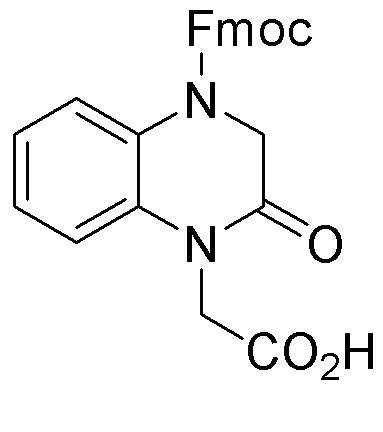Fmoc-4-carboxymethyl-1,2,3,4-tetrahydroquinoxalin-3-one is widely utilized in research focused on:
- Peptide Synthesis: This compound serves as a protective group in peptide synthesis, allowing for the selective modification of amino acids without interfering with other functional groups.
- Drug Development: It plays a role in the design of novel pharmaceuticals, particularly in creating compounds that target specific biological pathways, enhancing therapeutic efficacy.
- Bioconjugation: The compound can be used to create bioconjugates, linking drugs to biomolecules for targeted delivery, which is crucial in cancer therapy and other treatments.
- Analytical Chemistry: It is employed in the development of analytical methods to detect and quantify specific biomolecules, aiding in research and quality control in pharmaceuticals.
- Material Science: The chemical is explored for its potential in creating advanced materials, such as sensors and coatings, due to its unique structural properties.
General Information
Properties
Safety and Regulations
Applications
Fmoc-4-carboxymethyl-1,2,3,4-tetrahydroquinoxalin-3-one is widely utilized in research focused on:
- Peptide Synthesis: This compound serves as a protective group in peptide synthesis, allowing for the selective modification of amino acids without interfering with other functional groups.
- Drug Development: It plays a role in the design of novel pharmaceuticals, particularly in creating compounds that target specific biological pathways, enhancing therapeutic efficacy.
- Bioconjugation: The compound can be used to create bioconjugates, linking drugs to biomolecules for targeted delivery, which is crucial in cancer therapy and other treatments.
- Analytical Chemistry: It is employed in the development of analytical methods to detect and quantify specific biomolecules, aiding in research and quality control in pharmaceuticals.
- Material Science: The chemical is explored for its potential in creating advanced materials, such as sensors and coatings, due to its unique structural properties.
Documents
Safety Data Sheets (SDS)
The SDS provides comprehensive safety information on handling, storage, and disposal of the product.
Product Specification (PS)
The PS provides a comprehensive breakdown of the product’s properties, including chemical composition, physical state, purity, and storage requirements. It also details acceptable quality ranges and the product's intended applications.
Certificates of Analysis (COA)
Search for Certificates of Analysis (COA) by entering the products Lot Number. Lot and Batch Numbers can be found on a product’s label following the words ‘Lot’ or ‘Batch’.
*Catalog Number
*Lot Number
Certificates Of Origin (COO)
This COO confirms the country where the product was manufactured, and also details the materials and components used in it and whether it is derived from natural, synthetic, or other specific sources. This certificate may be required for customs, trade, and regulatory compliance.
*Catalog Number
*Lot Number
Safety Data Sheets (SDS)
The SDS provides comprehensive safety information on handling, storage, and disposal of the product.
DownloadProduct Specification (PS)
The PS provides a comprehensive breakdown of the product’s properties, including chemical composition, physical state, purity, and storage requirements. It also details acceptable quality ranges and the product's intended applications.
DownloadCertificates of Analysis (COA)
Search for Certificates of Analysis (COA) by entering the products Lot Number. Lot and Batch Numbers can be found on a product’s label following the words ‘Lot’ or ‘Batch’.
*Catalog Number
*Lot Number
Certificates Of Origin (COO)
This COO confirms the country where the product was manufactured, and also details the materials and components used in it and whether it is derived from natural, synthetic, or other specific sources. This certificate may be required for customs, trade, and regulatory compliance.


